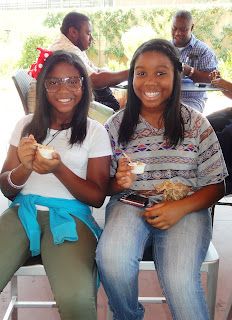On the last weekend in September, when the leaves in Atlanta were beginning to turn, Garden Chef Christina Curry brought our visitors a much anticipated taste of fall with this salad that calls for maple syrup, dried cranberries, and sweet potatoes.
Sweet potatoes grow very well in Georgia. They are extremely sensitive to frost and need warm, moist weather. They have a long growing season (about 150 days). In the Edible Garden, Sweet Potato ‘Porto Rico’ plants grew beside tomatoes all summer long. Plant them four weeks after the average date of last frost or when the soil is thoroughly warm. Sweet potatoes are planted from rooted sprouts, or slips, taken from a mature root.
There are a few ways to break down the fibers in raw vegetables to make them more palatable: 1. cooking; 2. using chemicals (such as lime juice); 3. grating. You don’t have to cook the potatoes for this recipe; you simply have to grate them.
Israeli Couscous, or pearled couscous, is more like pasta than rice. Rather than covering it with boiling water and leaving it to sit (covered), one should cook it like pasta, on the stove, for about seven minutes.
The flat-leaf parsley in the recipe, delicious this time of year, adds a taste of freshness, while the zest helps to bring the different flavors together. The result is a pleasantly moist, sweet salad that works well as a side dish or, if you have a sweet tooth, a scrumptious mid-afternoon snack.
Israeli Couscous, Sweet Potato & Apple Salad
2 cups cooked Israeli couscous
1 cup sweet potato, grated
1/2 cup apple, grated
1/4 cup golden raisins
1/4 cup dried cranberries
2 T thyme leaves
2 T Italian parsley, chopped
1/4 cup olive oil
1/4 cup cider vinegar
2 T maple syrup
1 T orange zest
1 T lemon zest
salt & pepper, to taste
In a bowl, gently combine couscous, sweet potato, apple, raisins, dried cranberries, thyme and parsley. Add the olive oil, cider vinegar, maple syrup, orange zest, lemon zest, salt and pepper. Mix well and allow the salad to marinate for 15 minutes before serving.
Don’t have any dried cranberries in your pantry, but have dried apricots instead? Want to use different herbs? Experiment with whatever you have on hand. All of Garden Chef Christina’s recipes should be considered “open to interpretation.” The one thing she does recommend sticking with is pure maple syrup - the really good stuff!
Discover more Garden Chef recipes here.




























